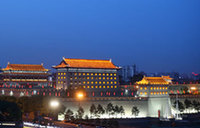Macao's many wonders
 |
|
[Photo by Xu Lin/China Daily] |
After enjoying the leisure and entertainment of the modern resorts, you can experience the city's rich cultures.
The locals like to visit the A-Ma Temple for the protection of Mazu, the Chinese goddess of the sea, who protects fishermen and sailors. Mazu is widely worshipped in coastal regions, such as Fujian province, Hong Kong and Taiwan. Pavilions of the temple are dedicated to other deities in Confucianism and Buddhism, such as Guanyin, or the Goddess of Mercy.
You can go to Mount Fortress to have a bird's-eye view of Macao on a 52-meter-high hill. Built in the early 17th century, the fortress was the city's principal military defense structure, equipped with cannons, military barracks, and an arsenal.
In 1998, the Macao Museum was built there to demonstrate the former Portuguese colony's history and cultures.
Next to the fortress is another Macao landmark, the Ruins of St. Paul's. It is actually a 27-meter-high stone facade located on a small hill, with 66 stone steps leading up to it.
The ruins of the Cathedral of St. Paul has a history of more than 410 years. The Portuguese cathedral was one of the largest Catholic churches in Asia at that time, and was destroyed by three fires at different times.
If you go:
There are many direct flights to Macao from major centers. You can also travel the entry ports of Zhuhai, Guangdong province, to reach Macao. It takes no more than 20 minutes by car from downtown to Macao International Airport. It's better to use Hong Kong dollars or Macao Pataca. There are local snack stores nearby scenic spots such as A-Ma Temple. You must try the dried pork slices, almond cakes and sweetheart cakes. After visiting Macao, you can take an one-hour boat journey or 16-minute helicopter ride to Hong Kong.
















